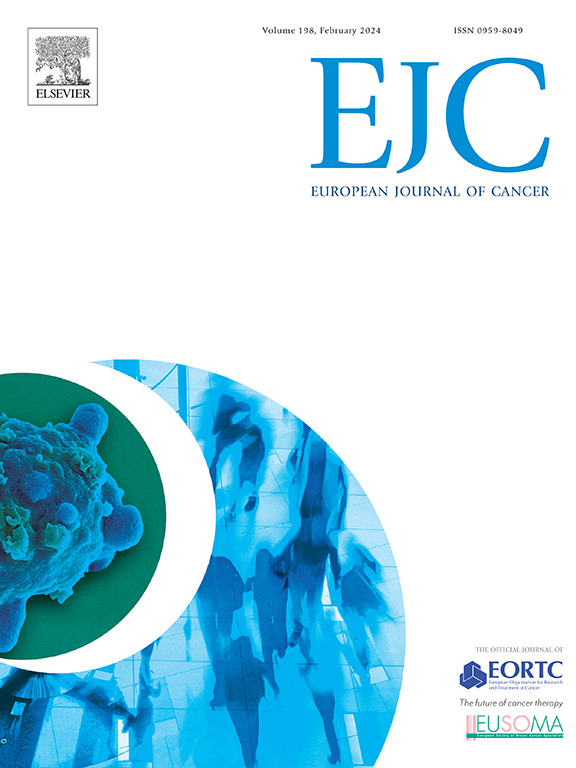Critical evaluation of sentinel lymph node biopsy in pT1b and pT2a melanoma patients: A nationwide population-based study
IF 7.6
1区 医学
Q1 ONCOLOGY
引用次数: 0
Abstract
Introduction
Sentinel lymph node biopsy (SLNB) aims to stage patients. According to the 8th edition of the American Joint Committee on Cancer(AJCC) staging manual, patients with pT1b or pT2a melanoma can be eligible for adjuvant immunotherapy, however, only if they have a sentinel node (SN) tumour burden > 1 mm. This study aims to determine the percentage of patients with pT1b or pT2a that will become eligible for adjuvant immunotherapy following SLNB.
Methods
A nationwide, population-based study was conducted using data from the Dutch Pathology Databank. Patients diagnosed with pT1b and pT2a melanoma between 2002 and 2023 were included. The primary endpoint was the number of SNs with a tumour burden > 1 mm.
Results
We identified 36,606 patients of who 16,042 underwent SLNB. SN positivity was 5 % for patients with pT1b melanoma, and 11 % for pT2a melanoma. A tumour burden > 1 mm was found in 1.5 % and 4.1 %, translating to a number needed to treat (NNT) of 69 for pT1b and 25 for pT2a.
Conclusion
This nationwide study demonstrated a low incidence of positive SNs and minimal likelihood of significant clinical outcomes following SLNB. Given the high NNT to be eligible for adjuvant immunotherapy, SLNB may no longer be justified for pT1b melanoma. For patients with pT2a melanoma, SLNB should be considered carefully, balancing limited clinical benefits against potential risks.
pT1b和pT2a黑色素瘤患者前哨淋巴结活检的关键评估:一项基于全国人群的研究
前哨淋巴结活检(SLNB)旨在对患者进行分期。根据第8版美国癌症联合委员会(AJCC)分期手册,pT1b或pT2a黑色素瘤患者可接受辅助免疫治疗,然而,只有当他们有前哨淋巴结(SN)肿瘤负担> 1 mm。本研究旨在确定SLNB后pT1b或pT2a患者有资格接受辅助免疫治疗的百分比。方法:使用荷兰病理学数据库的数据进行了一项全国性的、基于人群的研究。2002年至2023年间诊断为pT1b和pT2a黑色素瘤的患者被纳入研究。主要终点是具有肿瘤负荷的SNs数量> 1 mm。结果:我们确定了36,606例患者,其中16,042例接受了SLNB。pT1b黑色素瘤患者SN阳性为5 %,pT2a黑色素瘤患者SN阳性为11 %。肿瘤负荷> 1 mm分别为1.5 %和4.1 %,转化为pT1b所需治疗(NNT)的69和pT2a的25。结论:这项全国性的研究表明,SLNB后阳性SNs的发生率较低,显著临床结果的可能性很小。鉴于高NNT符合辅助免疫治疗的条件,SLNB可能不再适用于pT1b黑色素瘤。对于pT2a黑色素瘤患者,应谨慎考虑SLNB,平衡有限的临床获益与潜在风险。
本文章由计算机程序翻译,如有差异,请以英文原文为准。
求助全文
约1分钟内获得全文
求助全文
来源期刊

European Journal of Cancer
医学-肿瘤学
CiteScore
11.50
自引率
4.80%
发文量
953
审稿时长
23 days
期刊介绍:
The European Journal of Cancer (EJC) serves as a comprehensive platform integrating preclinical, digital, translational, and clinical research across the spectrum of cancer. From epidemiology, carcinogenesis, and biology to groundbreaking innovations in cancer treatment and patient care, the journal covers a wide array of topics. We publish original research, reviews, previews, editorial comments, and correspondence, fostering dialogue and advancement in the fight against cancer. Join us in our mission to drive progress and improve outcomes in cancer research and patient care.
 求助内容:
求助内容: 应助结果提醒方式:
应助结果提醒方式:


